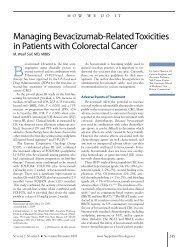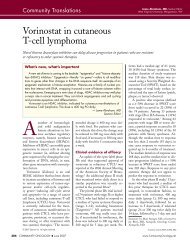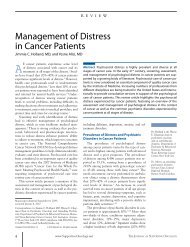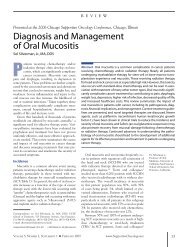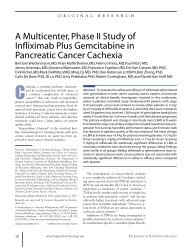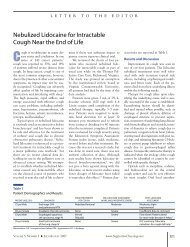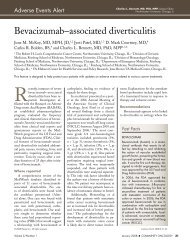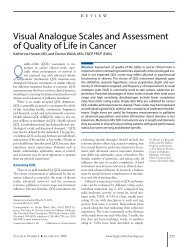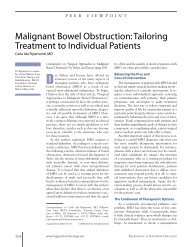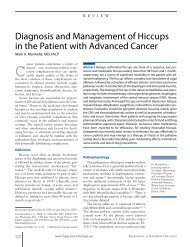Evaluation and management of gestational trophoblastic disease
Evaluation and management of gestational trophoblastic disease
Evaluation and management of gestational trophoblastic disease
Create successful ePaper yourself
Turn your PDF publications into a flip-book with our unique Google optimized e-Paper software.
<strong>Evaluation</strong> <strong>and</strong> <strong>management</strong> <strong>of</strong> GTD<br />
CHALLENGING CASES/RARE CANCERS<br />
ble early molar <strong>disease</strong>. 6,7 This is especially<br />
true for partial molar pregnancies,<br />
for which ultrasonographic<br />
characteristics may be difficult to<br />
identify prior to the second trimester;<br />
they are <strong>of</strong>ten diagnosed as missed<br />
abortions. There is no evidence that<br />
routine use <strong>of</strong> pathologic or early ultrasonographic<br />
studies is cost-effective<br />
or will decrease the incidence <strong>of</strong><br />
GTN, but some investigators recommend<br />
submitting all tissue obtained<br />
for histopathologic evaluation <strong>and</strong>/or<br />
follow-up with hCG testing. 8 Similar<br />
concerns have been expressed for<br />
women undergoing early elective termination<br />
<strong>of</strong> pregnancy.<br />
<strong>Evaluation</strong> <strong>and</strong> <strong>management</strong><br />
Initial evaluation for molar <strong>disease</strong><br />
should include a work-up for anemia,<br />
preeclampsia, electrolyte imbalance,<br />
<strong>and</strong> hyperthyroidism as well as a<br />
baseline chest x-ray. Pulmonary complications<br />
have been noted in patients<br />
with a <strong>gestational</strong> size greater than 16<br />
weeks <strong>and</strong> are associated with preeclampsia,<br />
fluid overload, anemia, hyperthyroidism,<br />
or emboli at the time<br />
<strong>of</strong> evacuation.<br />
Suction curettage is st<strong>and</strong>ard<br />
treatment, unless fetal structures (ie, a<br />
partial mole) preclude the use <strong>of</strong> this<br />
method. 9 Medical methods are associated<br />
with a higher rate <strong>of</strong> chemotherapy<br />
<strong>and</strong> should not be used. 9 If<br />
the patient does not wish future childbearing,<br />
a hysterectomy decreases the<br />
risk <strong>of</strong> malignant sequelae to 3%–5%<br />
but does not eliminate the need for<br />
close follow-up. A laparotomy set <strong>and</strong><br />
facilities for hemodynamic monitoring<br />
should be available during evacuation<br />
<strong>of</strong> the mole with significant uterine<br />
enlargement. Oxytocin should be<br />
initiated in the operating room before<br />
the procedure is performed, <strong>and</strong> blood<br />
products should be readily available.<br />
Hypertension <strong>and</strong> hyperthyroidism<br />
usually resolve acutely after evacuation,<br />
although it may take ovarian<br />
cysts from hCG stimulation several<br />
months to resolve.<br />
Follow-up<br />
Approximately 20% <strong>of</strong> complete<br />
molar pregnancies <strong>and</strong> 5% <strong>of</strong> partial<br />
molar pregnancies have malignant<br />
sequelae requiring chemotherapy<br />
after uterine evacuation. 10 Clinical<br />
features associated with such an increased<br />
risk include pre-evacuation<br />
hCG levels, uterine size, theca lutein<br />
cysts, associated medical factors, maternal<br />
age > 40 years, <strong>and</strong> previous<br />
molar pregnancy.<br />
After molar evacuation, patients<br />
should be followed with serial serum<br />
hCG values <strong>and</strong> are considered to<br />
have achieved remission when hCG<br />
levels decline to undetectable levels<br />
for 6 months. 11 The NETDC has<br />
suggested that postevacuation monitoring<br />
for women with uncomplicated<br />
molar pregnancy may be shortened<br />
without compromising risk, as<br />
no patient at this center recurred after<br />
achieving two consecutive undetectable<br />
hCG levels. 12 Patients also<br />
should use reliable contraception so<br />
as not to obscure the diagnosis <strong>of</strong> persistent<br />
or recurrent <strong>disease</strong>. Use <strong>of</strong><br />
oral contraceptives neither increases<br />
the risk <strong>of</strong> GTN nor causes a delay<br />
in achieving normal hCG values. 13<br />
Pelvic examination should document<br />
uterine involution <strong>and</strong> may identify<br />
early vaginal metastasis.<br />
Gestational <strong>trophoblastic</strong><br />
neoplasm<br />
Diagnosis<br />
After a complete molar pregnancy,<br />
the majority <strong>of</strong> cases <strong>of</strong> GTN will<br />
consist <strong>of</strong> nonmetastatic persistent or<br />
invasive moles. The minority <strong>of</strong> cases<br />
will involve metastatic <strong>disease</strong>, which<br />
may manifest histologically as a choriocarcinoma.<br />
The diagnosis <strong>of</strong> GTN<br />
after molar pregnancy is most commonly<br />
determined by persistently rising<br />
or plateauing hCG levels after<br />
evacuation; alternatively, GTN can be<br />
diagnosed if histologic results from the<br />
uterine evacuation show invasive molar<br />
proliferation, choriocarcinoma, or <strong>trophoblastic</strong><br />
tumor <strong>of</strong> the placental site.<br />
New intrauterine pregnancy should be<br />
ruled out on the basis <strong>of</strong> hCG levels<br />
<strong>and</strong> ultrasonographic findings.<br />
The FIGO Council 2000 criteria<br />
for the diagnosis <strong>of</strong> posthydatidiform<br />
mole GTN follow:<br />
■<br />
■<br />
■<br />
■<br />
A rise in hCG level <strong>of</strong> 10% or<br />
higher <strong>of</strong> three values recorded over<br />
2 weeks (days 1, 7, <strong>and</strong> 14)<br />
A plateau in hCG level ( ± 10%) <strong>of</strong><br />
four values recorded over 3 weeks<br />
(days 1, 7, 14, <strong>and</strong> 21)<br />
The persistence <strong>of</strong> a detectable hCG<br />
level at 6 months or more after<br />
evacuation <strong>of</strong> the mole<br />
A histologic diagnosis <strong>of</strong><br />
choriocarcinoma<br />
Less commonly, choriocarcinoma<br />
will develop after a nonmolar gestation,<br />
including normal pregnancy,<br />
abortion, or ectopic pregnancy. Cases<br />
not following a known prior molar<br />
pregnancy may present many years after<br />
an antecedent pregnancy, <strong>and</strong> diagnosis<br />
can initially be baffling. Having<br />
a high index <strong>of</strong> suspicion may avoid<br />
an unnecessary thoracotomy or craniotomy<br />
for diagnostic purposes when a<br />
simple hCG level can be diagnostic.<br />
Any woman <strong>of</strong> reproductive age with<br />
brain metastasis or cerebral hemorrhage<br />
<strong>of</strong> unexplained etiology should<br />
be screened for GTN with an hCG<br />
level. For the patient with abnormal<br />
bleeding for more than 6 weeks after<br />
pregnancy, dilation <strong>and</strong> curettage may<br />
be helpful, although <strong>disease</strong> is sometimes<br />
deep in the myometrium <strong>and</strong><br />
unobtainable by curettage. Additionally,<br />
<strong>disease</strong> may sometimes be confined<br />
to metastatic implants.<br />
False-positive or phantom<br />
hCG level results<br />
In 2001, the Society for Gynecologic<br />
Oncologists issued a warning<br />
regarding phantom hCG results.<br />
Laboratory assays for hCG levels may<br />
yield false-positive results, which have<br />
been reported to be as high as 800<br />
mIU/mL or possibly higher. These<br />
Volume 3/Number 3<br />
March 2006 ■ COMMUNITY ONCOLOGY 153



